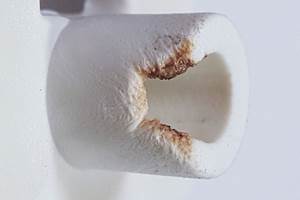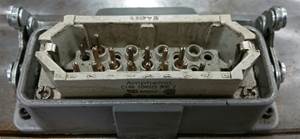Big Presses Get New Lease on Life With Control Retrofits
Updated controls save some very large machines from obsolescence.
One of the largest injection machines in North America gained new life last year from a “brain transplant”—a controls upgrade that converted it from a constant headache to trouble-free operation. The press was a one-of-a-kind machine (photo) built in 1999 with an 8800-ton clamp having eight tiebars, three of which retract for mold changes; a plunger/shot-pot injection unit fed by a reciprocating extruder; and a seven-axis, side-entry robot. The machine had been acquired along with a defunct molding plant in Shelbyville, Ky., by of Fairfield, Calif., a producer of reusable bulk containers. Unfortunately, the giant machine, originally built for Chrysler, had problems with its control system. “We could never depend on the press to run for more than a few hours without a cycle stoppage,” says plant manager Jonathan Kitchen. “We have another machine capable of handling the largest jobs. Moving the 77,000-lb mold back and forth between machines each time we had a problem was an arduous job, requiring two days of downtime.”
Macro called in Cincinnati Process Technologies (CPT), Cincinnati, a provider of injection machinery upgrades and other services. Sales manager Dane Bales says CPT has concentrated lately on upgrading large machines because “it’s easier to see the benefit of preserving that big capital investment with a retrofit.” The Macro case “was the largest and most complex control system replacement we’ve done to date,” says CPT application engineer Jim O’Bryan. CPT installed control hardware from Atlanta-based (which it uses exclusively), along with CPT’s own software. Says Macro’s Kitchen, “Now we can start it up and it will run continuously without so much as a glitch.”
CPT accomplished other big projects in 2014. It outfitted new controls on one of the largest low-pressure structural-foam machines in the world for to produce large septic ad potable-water tanks in Winchester, Ky. Each PP tank measures up to 15 ft long and weighs 245 lb. They are molded on a mammoth press that Infiltrator constructed by joining together the clamps from two 1990s-era foam presses, for a total of 6000 tons of clamp force. The two injection units, plus a third, were mounted on this custom machine. For the control, CPT used B&R’s Panel PC with 15-in. touchscreen (photo). Due to the machine size, four I/O racks were located closest to their points of use, which drastically reduced the amount of wire and assembly time.
Last year, CPT also retrofitted two 750-ton structural-foam presses from the 1990s at in Bluffton, Ind., and will do a third at the firm’s Springfield, Mo., facility. Buckhorn molds large reusable bulk containers weighing up to 150 lb. Buckhorn aimed to install sequential valve gating (SVG) on these machines to cut material loss by reducing overfilling and improve part quality through tighter knit-line control and consistent cavity filling in molds with high length-to-thickness ratios. With SVG and new controls from CPT, Buckhorn saw better fills, shorter cycles, and more than 20% reduction in clamp tonnage. Rex Reynolds, Buckhorn maintenance manager at Bluffton, says the upgrade will extend machine life and provide energy and material savings well beyond the estimated two-year ROI for the project.
CPT, which will exhibit at NPE2015 this month in Orlando, Fla., also supplies and injection presses, robots and automation systems, new and remanufactured parts, screws and barrels, variable-speed drives, and energy-efficient lighting.
Related Content
What to Look for in High-Speed Automation for Pipette Production
Automation is a must-have for molders of pipettes. Make sure your supplier provides assurances of throughput and output, manpower utilization, floor space consumption and payback period.
Read MoreProcess Monitoring or Production Monitoring — Why Not Both?
Molders looking to both monitor an injection molding process effectively and manage production can definitely do both with tools available today, but the question is how best to tackle these twin challenges.
Read MoreBack to Basics on Mold Venting (Part 1)
Here’s what you need to know to improve the quality of your parts and to protect your molds.
Read MoreHot Runners: How to Maintain Heaters, Thermocouples, and Controls
I conclude this three-part examination of real-world problems and solutions involving hot runners by focusing on heaters, thermocouples, and controls. Part 3 of 3.
Read MoreRead Next
People 4.0 – How to Get Buy-In from Your Staff for Industry 4.0 Systems
Implementing a production monitoring system as the foundation of a ‘smart factory’ is about integrating people with new technology as much as it is about integrating machines and computers. Here are tips from a company that has gone through the process.
Read MoreLead the Conversation, Change the Conversation
Coverage of single-use plastics can be both misleading and demoralizing. Here are 10 tips for changing the perception of the plastics industry at your company and in your community.
Read MoreFor PLASTICS' CEO Seaholm, NPE to Shine Light on Sustainability Successes
With advocacy, communication and sustainability as three main pillars, Seaholm leads a trade association to NPE that ‘is more active today than we have ever been.’
Read More











